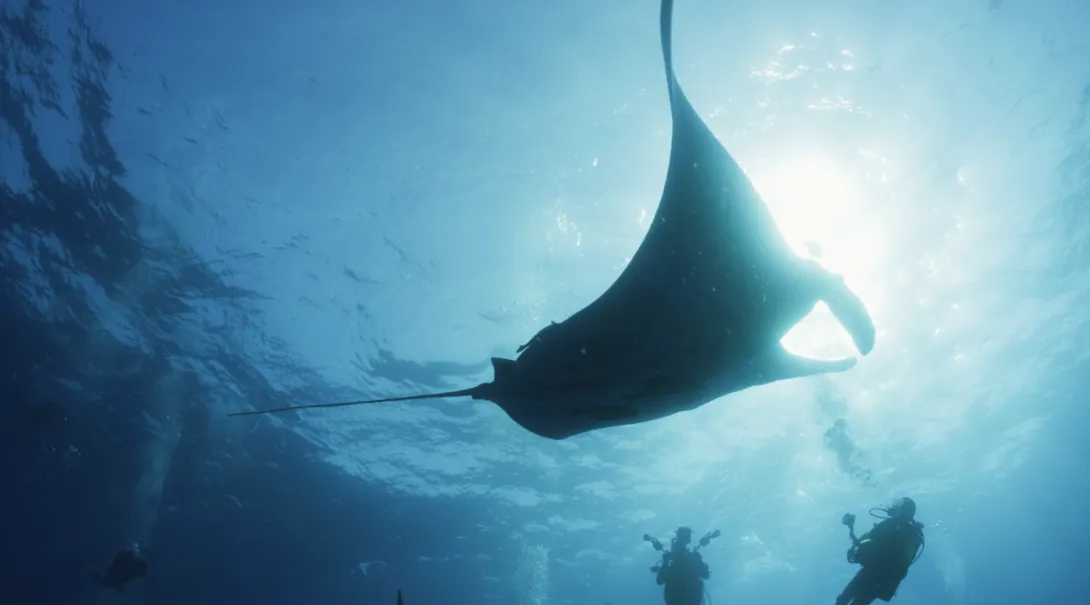We only conserve what we learn to love
Meet the mysterious giants of the sea
Giant manta rays are the largest rays in the world with wingspans up to 29 feet wide and weighing up to 5,300 pounds. They are surprisingly smart and have the biggest brains of any fish studied so far!
They use that brain power to learn, exercise their memory, distinguish between objects, and even recognize themselves in the mirror. Giant manta rays are found worldwide in tropical, subtropical, and temperate waters.
Conservation
Revillagigedo Archipelago is currently the largest fully protected marine reserve in North America and a UNESCO world heritage site. However, it wasn't always this way. A series of illegal fishing events that devastated the Pacific oceanic manta rays was the catalyst needed for Mexico to declare the Revillagigedo Archipelago a biosphere reserve. Terry was a huge part in making this happen and he's a phenomenal example of how much positive change a determined individual can create.
Right now, the last stable population of oceanic manta rays swim around this unique archipelago, highlighting the crucial importance of marine protected areas, yet just 8.4% of the ocean and coastal areas are currently protected.
Thankfully, there's a global movement to protect at least 30 percent of the ocean by 2030. At COP15 in December 2022, global leaders committed to this pressing initiative, and numerous international and local governments have also joined the 30x30 movement. Now, it is imperative that we hold leaders accountable to their pledges.
We hope Terry's story will help inspire viewers to join our community of manta ray defenders. Through our social media channels and newsletter, we aim to amplify action alerts from our conservation partners and mobilize our manta community to take action on some of the most important movements to safeguard these species' survival.
Protection
Manta rays and devil rays are in trouble, and time is running out. All ten known species are now threatened with extinction, with some populations declining by over 90% due to overfishing, the trade in their meat and gill plates, and misleading claims of “sustainable” fishing.
Recently, a significant victory was achieved as manta rays were officially protected under Appendix I at the CITES CoP in November. This protection prohibits international commercial trade, giving these ocean giants a real chance at survival.
The uplisting to Appendix I further enhances protections against the illegal wildlife trade, a crucial step for species facing severe exploitation.
Research on manta rays is also critical to achieving effective conservation measures. They are threatened by unregulated fishing, entanglement in discarded fishing gear, unsustainable tourism practices, and microplastic pollution. As populations decline, the value of their gill plates in illegal Asian markets rises, further exacerbating their vulnerability.
Through Willy's Legacy, we aim to support organizations committed to the protection and research of manta rays. By fundraising for crucial studies and research projects, we can enhance our understanding of these species and their ecosystems, making the ocean a safer place for manta rays.
Healing Power of the Ocean
For those suffering from trauma, the ocean offers something no pill or prescription ever could—a quiet, immersive world where the past can be left on the surface. From the coastlines of Scotland to the reefs of Cozumel, doctors and veterans alike are turning to "blue therapy," a growing body of research and real-world experience that shows time in or near the sea reduces stress, anxiety, and symptoms of PTSD. Scuba diving, in particular, is proving transformative for veterans coping with psychological and physical wounds. Beneath the waves, mobility is restored, pain is relieved, and emotional barriers begin to dissolve. Divers report a return of purpose, connection, and calm. As one wounded veteran described it, “Underwater, the demons are silent.” Like Terry’s encounters with Willy, these moments hint at something deeper—a healing presence in the ocean that science is only beginning to understand.
